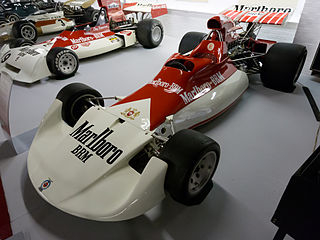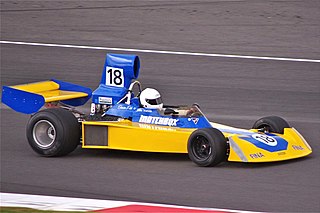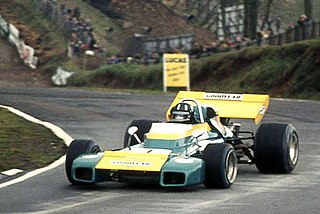
The 1976 Formula One season was the 30th season of FIA Formula One motor racing. It featured the 1976 World Championship of Drivers and the 1976 International Cup for Formula 1 Manufacturers. The two titles were contested over a sixteen race series which commenced on 25 January and ended on 24 October. Two non-championship races were also held during the 1976 season.

The BRM P180 was a Formula One racing car, built by BRM and designed by Tony Southgate which raced in the 1972 Formula One season. It was powered by a BRM 3.0-litre V12 engine. One of the main features of the P180 was that the radiators had moved to the rear of the car, allowing the nose of the car to be very wide and flat. It competed in five World Championship Grands Prix, with a total of seven individual entries. The car scored no World Championship points, its best finish being eighth at the 1972 Italian Grand Prix.

The BRM P160 was a Formula One racing car designed by Tony Southgate for the British Racing Motors team, which raced in the 1971, 1972, 1973 and 1974 Formula One seasons. It was powered by a 3.0-litre V12 engine.

The BRM P138 was a Formula One racing car designed by Len Terry which raced in the 1968 and 1969 Formula One seasons. It was powered by a 3.0-litre V12 engine.

The BRM P126 was a Formula One racing car which raced in the 1968 and 1969 Formula One seasons. It was powered by a 3.0-litre V12 engine. Design was contracted out to former Lotus and Eagle designer Len Terry and the three examples built were constructed by his Transatlantic Automotive Consultants company due to pressure of work at BRM.
The Brabham BT48 was a Formula One racing car designed by Gordon Murray and raced by the Brabham team. The car, powered by a 12-cylinder Alfa Romeo engine, competed in the 1979 Formula One season. The intended plan was to run the BT47 but the FIA outlawed it because it had a Chaparral 2J-type box rear end with twin variable geometry fans on the rear to maximize ground effect, so Murray designed the BT48 instead.

The Hesketh 308C was a Formula One racing car designed by Harvey Postlethwaite and used by Hesketh Racing in the latter stages of the 1975 Formula One season. The car featured the rubber suspension which Postlethwaite had pioneered on the preceding 308B model and a Ford-Cosworth DFV engine. In 1976, the car was acquired by Wolf–Williams Racing and rebranded as the Wolf–Williams FW05.

The Matra MS120 was the fifth and final Formula One car produced by Matra.

The Lola T370 was a Formula One car designed by Andy Smallman and used by Embassy Hill in the 1974 season and the early part of the 1975 season. After an unsuccessful 1973 with a customer Shadow DN1, the Embassy Hill team commissioned its own cars from Lola. The T370 was largely based on Formula 5000 designs, and looked similar to Lola's F5000 cars, although it sported an extremely large airbox. Embassy Hill had two cars for Graham Hill and Guy Edwards. The car was tested well before the end of 1973 in readiness for the January start to the 1974 season.

The Tyrrell 002 is a Formula One racing car which was designed for the 1971 and 1972 Formula One seasons by Tyrrell's Chief Designer, Derek Gardner. It was essentially the same design as the Tyrrell 001, but incorporated some detail changes, and 002 were built with longer monocoques, as François Cevert was taller than Jackie Stewart.

The Williams FW was a Formula One car used by Frank Williams Racing Cars during the 1973, 1974 and 1975 seasons. It was designed by John Clarke.

The Fittipaldi FD was a series of Formula One chassis designed by Richard Divila and used by Fittipaldi Automotive in the 1975, 1976 and 1977 seasons. The initial chassis was designated Fittipaldi FD01 and there were three minor developments designated, Fittipaldi FD02, Fittipaldi FD03 and Fittipaldi FD04 respectively. FD series cars competed in 37 races making 43 individual entries in total. The chassis achieved a best finish of fourth place at both the 1977 Argentine and Brazilian Grands Prix driven on each occasion by former World Champion and joint team-owner Emerson Fittipaldi. It scored a total of 11 World Championship points.

The Surtees TS16 was a Formula One car used by Surtees during the 1974, 1975 and 1976 Formula One seasons. It was designed by John Surtees.

The Surtees TS19 was a Formula One (F1) car used by Surtees during the 1976, 1977 and 1978 F1 seasons. It was designed by John Surtees and Ken Sears.

The Penske PC1 was a Formula One racing car developed and raced by Penske Racing during the 1974 and 1975 Formula One seasons. The car was designed by Geoff Ferris, and was raced by drivers Mark Donohue and John Watson. The PC1 entered and competed in 12 Grands Prix, and was replaced by the Penske PC3 in the 1976 season.

The Spirit 101 was a Formula One car for the 1984 and 1985 Formula One seasons. The car was designed by Gordon Coppuck and Tim Wright.
The Parnelli VPJ4 was a Formula One racing car designed by Maurice Philippe, and used by Vel's Parnelli Jones Racing during the 1974, 1975 and 1976 Formula One seasons.

The Brabham BT34 was a Formula One racing car designed by Ron Tauranac, and used by Brabham during part of the 1971 and 1972 Formula One seasons.

The Tyrrell 007 is a Formula One racing car, designed by Tyrrell's Chief Designer, Derek Gardner. It was used in the 1974, 1975, 1976 and 1977 Formula One seasons.

The ATS HS1 was a Formula One car used by ATS during the 1978 Formula One season. It was designed by John Gentry and Robin Herd.



















